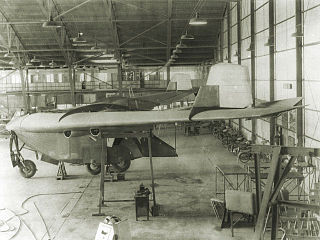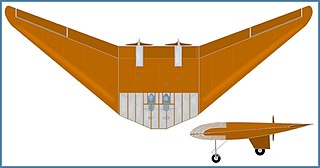
The Horten H.IX, RLM designation Ho 229 was a German prototype fighter/bomber initially designed by Reimar and Walter Horten to be built by Gothaer Waggonfabrik late in World War II. It was the first flying wing to be powered by jet engines.

The Horten H.XVIII was a proposed German World War II intercontinental bomber, designed by the Horten brothers. The unbuilt H.XVIII represented, in many respects, a scaled-up version of the Horten Ho 229, a prototype jet fighter. The H.XVIII was one of many proposed designs for an Amerikabomber, and would have carried sufficient fuel for transatlantic flights. The XVIIIA variant, with its wood structure, buried engines in the fuselage, flying wing design and carbon-based glue component, would have been, in theory, the first stealth bomber in history.

The Schempp-Hirth Nimbus 3 is a glider built by Schempp-Hirth.

The Horten H.IV was a German tailless flying wing glider in which the pilot was to lie in a prone position to reduce the frontal area, and hence drag. It was designed by Reimar and Walter Horten in Göttingen. Four were built between 1941 and 1943. They were flown in a number of unofficial competitions in Germany during World War II. After the war the flying examples were transported to the United Kingdom and the United States where several contest successes were achieved.

The DINFIA IA 38 was a 1960s Argentine four-engine experimental tailless transport aircraft, designed under the direction of Reimar Horten and based on the German Horten Ho VIII project and built by the DINFIA.

The Fauvel AV.22 was an unorthodox glider produced in France in the 1950s, 60s, and 70s. Originally intended to be produced in series, it was later marketed to homebuilders. Like other Charles Fauvel designs, it was a tailless aircraft, and this particular design featured wings with a slight forward sweep.
The ICA IS-32 is an open class high-performance metal two-seat sailplane produced in Romania in the 1970s. A refinement of the IS-28B, it shared most of that aircraft's fuselage, mated to new wings and empennage. This new wing had a span of 20 metres, featuring interconnected ailerons and flaps, Schempp-Hirth-type airbrakes. It had no provision for water ballast. The monowheel undercarriage differed from the IS-28 in being fully retractable.

The ASK 16 was designed by Rudolf Kaiser for production by Alexander Schleicher GmbH & Co of Furth, Germany. The aircraft is of welded tube, wood and fabric construction and has a low-set high-aspect-ratio wing.

The Horten H.VI was a flying wing aircraft designed by the Horten brothers during World War II.

The SZD-20x Wampir II was a single-seat tail-less research glider designed and built in Poland from 1959.

The I.Ae. 34 Clen Antú, sometimes known as the Horten XVa after its designer Reimar Horten, was a two-seat tailless glider built in Argentina. Two single-seat variants competed unsuccessfully in the 1952 World Gliding Championships.

The I.Ae.41 Urubú was a two-seat flying wing tailless glider, built in Argentina by the Fábrica Militar de Aviones (FMA) in the 1950s.

The Horten H.III was a flying wing sailplane built by Walter and Reimar Horten in Germany from 1937 to 1944.
The Akaflieg Braunschweig SB-8 is an experimental, single-seat, high performance glider built in Germany in the 1960s, constructed largely from glass fibre skin over built up balsa wood structure. Two were built; the second of which was later fitted with a high aspect ratio (30:1) wing, becoming the Akaflieg Braunschweig SB-9 Stratus.
The Horten H.II Habicht (Hawk) was a German flying wing glider built in Germany in 1935. Four, including one flown mostly as a motorglider, were built. One of the gliders was used to test the aerodynamics of a prototype World War II Horten jet fighter-bomber.
The Wings of Change Chinhook Bi is an Austrian two-place paraglider that was designed by Markus Gründhammer and produced by Wings of Change of Fulpmes. It is now out of production.

The Horten H.V was a delta-winged, tail-less, twin-engined motor-glider designed and built in the late 1930s and early 1940s by Walter and Reimar Horten in Germany. The H.V aircraft were used for various experimental duties, including: innovative structure, performance, stability and control of flying wing aircraft. The first H.V was the first aircraft to be built using an all composite material structure.
The Horten H.I was a German flying wing research glider built by Walter and Reimar Horten in 1933.

The Horten H.VII was a flying wing fighter-trainer aircraft designed by the Horten brothers during World War II.
The Fauvel AV.29 was a design for a transport plane by Charles Fauvel in the late 1930s.














